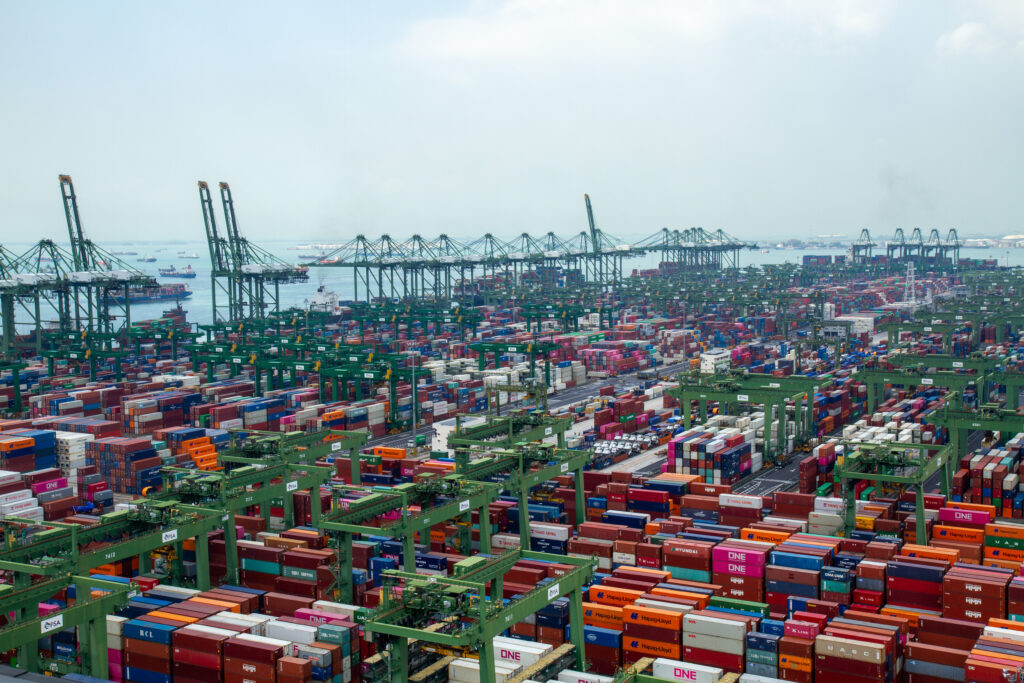Beyond the Big Three Banks: Singapore's Evolving Blue-Chip Landscape in 2025
The narrative around Singapore blue-chip investing has remained remarkably static for decades—DBS, OCBC, and UOB dominating headlines whilst REITs and telecoms play supporting roles. Yet scratch beneath the surface of 2025's market dynamics, and a far more nuanced story emerges. Whilst traditional stalwarts continue delivering steady dividends, a new generation of blue-chip candidates is quietly building track records that could reshape portfolios for the next decade.
The conventional wisdom suggests that in uncertain economic times—and make no mistake, Singapore's GDP growth forecast of 0.0-2.0% for 2025 represents significant uncertainty—investors should flee to the safety of established giants. But what if that conventional wisdom is missing the point? What if the most interesting opportunities lie not in the STI's top-heavy constituents, but in the companies gradually earning their stripes as tomorrow's blue-chips?

The Banking Triumvirate: Still Compelling, But Increasingly Predictable
Let's start with what everyone knows. Singapore's three local banks continue to demonstrate why they've dominated portfolios for generations. DBS Group posted record net profit of S$11.4 billion for FY2024, an 11% increase, whilst maintaining its 18.0% return on equity. OCBC achieved S$7.59 billion in net profit, up 8% year-on-year, bolstered by robust wealth management growth. UOB rounded out the trio with S$6.0 billion in net profit, a 6% increase, enhanced by its S$3 billion capital return programme.
The numbers are undeniably impressive. Current dividend yields hover around 5-6% across the trio, providing attractive income in a low-rate environment. But here's the rub: these results were largely anticipated. The market has efficiently priced in the banks' operational excellence, regulatory compliance, and dividend reliability. For investors seeking asymmetric returns—the kind that build wealth rather than merely preserve it—the established banks may be reaching the limits of their surprise potential.
Consider the structural headwinds. Singapore's GDP forecast has been downgraded amid US-China tariff tensions, core inflation is projected at just 0.5-1.5% for 2025, and net interest margins face pressure from the monetary easing cycle. Whilst these banks will undoubtedly navigate challenges successfully, their massive market capitalisations—DBS alone commands over S$121 billion—limit the scope for dramatic re-rating.

The Emerging Blue-Chip Thesis: Quality at Reasonable Prices
The more intriguing opportunities may lie among companies transitioning from mid-cap growth stories to blue-chip reliability. Take VICOM (SGX: WJP), Singapore's vehicle testing monopoly, which reported 18.9% year-on-year revenue growth to S$33.3 million in Q1 2025. Whilst the absolute numbers appear modest compared to banking behemoths, VICOM enjoys genuine pricing power through its regulatory mandate and is benefiting from the Electronic Road Pricing 2.0 rollout.
The company's defensive characteristics—mandatory vehicle inspections don't disappear during recessions—combined with growth catalysts like increased vehicle populations and enhanced testing requirements, create an attractive risk-return profile. Yet VICOM trades with minimal attention from institutional investors, creating potential for multiple expansion as it demonstrates sustained earnings growth.
Similarly, UMS Integration (SGX: 558) represents a compelling play on the semiconductor industry's recovery. The company posted 8% year-on-year revenue growth to S$57.7 million in Q1 2025, with management reporting strong order flow from a new key customer seeking to diversify supply chains away from US sources. With fab equipment spending projected to rise 18% to US$130 billion, driven by artificial intelligence and high-performance computing demand, UMS is positioned to benefit from a multi-year cycle.
The semiconductor equipment space offers higher growth potential than traditional blue-chips, but companies like UMS are gradually developing the operational consistency and financial strength that characterise mature blue-chip stocks. The key insight: investors can potentially capture this transition at reasonable valuations before broader market recognition drives premium pricing.
REITs: The Unsung Heroes of Singapore's Blue-Chip Story
Singapore's REIT sector deserves special attention in the 2025 landscape, not merely for income generation but as genuine blue-chip alternatives. CapitaLand Integrated Commercial Trust (CICT) exemplifies this evolution. With S$24.5 billion in assets and a 5.6% annualised distribution yield, CICT offers the scale and reliability traditionally associated with blue-chip stocks.
More importantly, CICT's recent performance demonstrates operational excellence beyond simple property ownership. The trust maintained a 96.8% committed occupancy rate through strategic leasing and proactive asset management, whilst pursuing value-accretive acquisitions like the proposed Ion Orchard stake. This combination of defensive characteristics and growth optionality positions quality REITs as legitimate blue-chip alternatives.
CapitaLand Ascendas REIT's recent S$700 million acquisition of two Singapore properties illustrates the sector's evolution. These aren't passive yield vehicles but actively managed businesses making strategic capital allocation decisions. As traditional blue-chip yields compress, REITs offer comparable income with potentially superior total returns through asset appreciation.

Technology's Blue-Chip Aspirations: Singapore's Quiet Tech Champions
Whilst Singapore lacks the headline-grabbing tech giants of other markets, several technology-adjacent companies are building blue-chip credentials through consistent execution. Singapore Technologies Engineering emerged as Q1 2025's top STI performer with a 45.7% rally, driven by its diversified aerospace, electronics, and smart city solutions.
ST Engineering's transformation from a traditional defence contractor to a technology solutions provider illustrates how established companies can achieve blue-chip status in new sectors. The company's involvement in autonomous systems, cybersecurity, and urban solutions positions it to benefit from multi-decade infrastructure trends whilst maintaining the financial stability expected of blue-chip stocks.
Venture Corporation (SGX: V03) provides another technology angle, serving as a contract manufacturer for healthcare, molecular diagnostics, and medical devices. Despite Q1 2025 revenue declining 7.5% to S$616.6 million, management's confidence in gaining market share across three to four technology domains suggests underlying business strength. For investors seeking technology exposure within a blue-chip framework, Venture offers operational diversification beyond traditional sector classifications.

The Logistics and Transport Revolution: ComfortDelGro's Reinvention
ComfortDelGro Corporation presents a fascinating case study in blue-chip evolution. The transport operator reported revenue growth of 16.4% to S$1.17 billion in Q1 2025, driven by international acquisitions and improved margins. But the real story lies in the company's strategic transformation.
CDG's development of robotaxi operations through a 100-vehicle trial in Nansha, Guangzhou signals ambitions far beyond traditional transport services. If successful, this initiative could position CDG at the forefront of autonomous mobility—a market with trillion-dollar potential. The company's extensive fleet management experience and regulatory relationships provide competitive advantages in deploying autonomous technologies at scale.
This represents precisely the kind of evolution that creates blue-chip opportunities. CDG maintains the stable cash flows and dividend payments expected of mature companies whilst pursuing transformative growth initiatives that could redefine its industry position. Investors can essentially access a venture-stage autonomous vehicle play within a dividend-paying blue-chip wrapper.

The Food and Beverage Frontier: Quality Brands, Developing Markets
Fraser & Neave's recent milestone of welcoming 2,500 dairy cattle to its Malaysian integrated dairy farm might seem unremarkable, but it illustrates how traditional consumer companies are building vertical integration and regional scale. With fresh milk production commencing under the Magnolia brand, F&N is strengthening its competitive moat in Southeast Asian dairy markets.
The company's 13.2% revenue growth to S$1.2 billion in H1 FY2025 reflects successful brand management and market expansion. In an era where consumer preferences increasingly favour trusted, established brands, F&N's portfolio spanning 100Plus, Nutri-Soy, and Magnolia provides defensive characteristics with regional growth potential.

Sheng Siong Group offers another consumer angle, having achieved 5.0% revenue growth to S$363.2 million in Q3 2024 through new store expansion and improved margins. The company's track record of securing 44% of HDB store tenders over five years demonstrates competitive advantages in Singapore's retail market. For investors seeking domestic consumption exposure, Sheng Siong provides recession-resistant characteristics with steady expansion potential.
The Wealth Management Revolution: Singapore's Financial Services Evolution
Beyond traditional banking, Singapore's emergence as a wealth management hub creates opportunities in adjacent financial services. This trend benefits not only banks but also companies providing supporting infrastructure and services. The wealth management boom, evidenced by DBS's 45% increase in wealth fees to S$2.18 billion, creates spillover effects across Singapore's financial ecosystem.
Companies positioned to benefit from this trend include exchanges, custodians, and technology providers. Singapore Exchange Limited (SGX) exemplifies this opportunity, having reported 15.6% growth in net revenue to S$646.4 million in H1 FY2025. The exchange's securities daily average volume surge of 59% to S$1.9 billion in April reflects increasing market activity.
SGX's monopoly position in Singapore, combined with growing regional capital market integration, provides blue-chip characteristics with significant leverage to Asia's financial development. Exchange operators historically demonstrate remarkable pricing power and defensive moats, making SGX an attractive play on Singapore's financial centre ambitions.
Telecommunications: Beyond Connectivity to Digital Infrastructure
Singapore Telecommunications (Singtel) continues evolving beyond traditional telco services into digital infrastructure and regional connectivity. The company's ST28 strategy targeting S$6 billion in capital recycling by FY2027 demonstrates management's commitment to strategic transformation.
Singtel's expansion into data centres through Nxera, targeting 155MW capacity across Singapore, Thailand, and Indonesia, positions the company to benefit from Southeast Asia's digital transformation. The introduction of a value realisation dividend of 3-6 cents per share alongside the traditional dividend provides additional shareholder returns whilst funding growth investments.
Insight: Singtel maintains blue-chip characteristics—stable cash flows, regional market positions, dividend reliability—whilst pursuing high-growth digital infrastructure opportunities. This combination appeals to investors seeking both income and exposure to Asia's technology-driven future.

The Valuation Paradox: Quality at Discounted Prices
Perhaps the most intriguing aspect of Singapore's 2025 blue-chip landscape is the valuation disconnect between quality and price. Whilst global markets trade at elevated multiples, Singapore's focus on dividend yields and conservative accounting often results in quality companies trading below intrinsic value.
Consider VICOM's regulatory monopoly, UMS Integration's semiconductor cycle positioning, or ComfortDelGro's autonomous vehicle optionality. These companies offer genuine competitive advantages and multi-year growth catalysts, yet trade at valuations that suggest limited growth expectations. This disconnect creates opportunities for patient investors willing to look beyond traditional blue-chip classifications.
The broader economic context—slow GDP growth, moderate inflation, and monetary easing—actually favours this patient approach. Rather than chasing growth at any price, investors can accumulate quality companies at reasonable valuations whilst enjoying attractive dividend yields during the holding period.

Sector Rotation and Regional Dynamics: The Asian Century Thesis
Singapore's blue-chip evolution reflects broader Asian economic dynamics. As supply chains diversify away from China, Southeast Asian manufacturing hubs benefit. As wealth accumulates across the region, Singapore's financial services sector captures increasing assets under management. As technology adoption accelerates, infrastructure and logistics companies gain strategic importance.
This regional positioning provides Singapore blue-chips with structural tailwinds independent of domestic economic performance. Companies like UOB, with significant ASEAN exposure, or Singtel, with regional digital infrastructure investments, offer indirect plays on Asian economic development through established, dividend-paying vehicles.
The currency dimension adds another layer. Singapore dollar strength relative to regional currencies enhances the purchasing power of local companies making regional acquisitions, whilst foreign investors benefit from currency stability compared to more volatile emerging market alternatives.
Risk Factors and Contrarian Considerations
No investment thesis is complete without acknowledging risks. Singapore's economic dependence on global trade makes local companies vulnerable to supply chain disruptions and tariff wars. The 0.0-2.0% GDP growth forecast for 2025 suggests potential earnings pressure across sectors.
Interest rate sensitivity remains a concern, particularly for REITs and high-dividend stocks. Rising rates could pressure valuations, though Singapore's measured monetary policy approach may limit downside compared to more aggressive central bank actions elsewhere.
Regulatory risks vary by sector. Transport companies face changing mobility regulations, financial services encounter evolving compliance requirements, and technology companies navigate data privacy and cybersecurity mandates. Whilst established companies typically possess resources to adapt, regulatory changes can impact competitive dynamics and profitability.
Perhaps most importantly, the blue-chip evolution thesis requires patience. Market recognition of emerging blue-chip characteristics often lags operational improvements by quarters or years. Investors must be prepared to hold through periods of relative underperformance whilst companies build track records and market confidence.

Implementation Strategy: Building Tomorrow's Blue-Chip Portfolio
For investors convinced by the emerging blue-chip thesis, implementation requires balancing conviction with prudence. A core portfolio might include established names like DBS and CICT for stability and income, whilst allocating meaningful positions to companies like VICOM, UMS Integration, and ComfortDelGro for growth optionality.
Diversification across sectors remains crucial. Technology exposure through ST Engineering and Venture Corporation, consumer exposure through Sheng Siong and F&N, and infrastructure exposure through Singtel and CDG provides broad economic participation whilst maintaining quality bias.
Regular monitoring and rebalancing allow investors to capture price dislocations whilst maintaining long-term perspective. Companies demonstrating consistent execution and expanding competitive moats deserve increased allocations, whilst those failing to meet growth expectations should be reduced.
The 2025 Opportunity: Capturing Value Before Consensus
The most compelling aspect of Singapore's blue-chip evolution is timing. Global markets increasingly recognise Asia's long-term growth potential, regional supply chain importance, and demographic advantages. Singapore's political stability, regulatory framework, and financial infrastructure position local companies to benefit from these trends.
Yet market attention remains focused on traditional metrics—dividend yields, book values, and historical price-to-earnings ratios. This creates opportunities for investors willing to evaluate companies based on future earning power rather than past performance. The transition from growth stories to blue-chip reliability represents a particularly attractive entry point, offering upside participation with downside protection as companies mature.
The 2025 investment landscape favours this approach. Economic uncertainty reduces appetite for speculative positions whilst highlighting the value of quality businesses with predictable cash flows. Moderate growth expectations create opportunities to acquire excellent companies at reasonable prices, setting the stage for attractive returns as business fundamentals compound over time.
Beyond the Obvious
Singapore's blue-chip landscape in 2025 extends far beyond the traditional banking and REIT triumvirates that dominate headlines. Whilst established players continue delivering reliable returns, the most interesting opportunities may lie among companies gradually building blue-chip credentials through operational excellence, strategic positioning, and competitive advantage development.
The key insight: blue-chip status is earned, not inherited. Companies like VICOM, UMS Integration, ComfortDelGro, and Singapore Exchange are demonstrating the consistency, market position, and shareholder-friendly policies that define blue-chip investing. Yet they trade at valuations that suggest limited recognition of their evolving status.
For investors willing to look beyond conventional classifications, 2025 offers a unique opportunity to build portfolios combining the stability of established blue-chips with the asymmetric return potential of emerging quality companies. In an economic environment favouring patience over speculation, this approach aligns risk management with return enhancement.
The blue-chip evolution continues. The question isn't whether Singapore will develop new blue-chip companies, but which investors will recognise them before the market consensus catches up. In the quietly efficient Singapore market, this recognition gap may not last long—but for now, it represents one of the more compelling opportunities in a challenging global investment environment.
Questions People May Have:
Q: Are these emerging blue-chips as safe as traditional banks? A: Not initially, but companies like VICOM and UMS Integration are building defensive characteristics through market position and consistent execution. The trade-off is accepting slightly higher risk for potentially superior returns.
Q: How do dividend yields compare between traditional and emerging blue-chips? A: Traditional blue-chips typically offer 4-6% yields, whilst emerging candidates may yield 2-4% but offer superior total return potential through capital appreciation.
Q: Should I replace traditional blue-chips with emerging ones? A: No—the optimal approach combines both for diversification. Traditional blue-chips provide stability whilst emerging ones offer growth optionality.
Q: What timeframe should I expect for emerging blue-chips to be recognised? A: Market recognition typically follows 3-5 years of consistent performance. Companies demonstrating blue-chip characteristics during economic stress often gain recognition faster.
Q: How do I evaluate if a company is becoming a blue-chip? A: Look for consistent earnings growth, improving margins, market leadership, shareholder-friendly policies, and defensive business models. Financial strength and dividend sustainability are key indicators.
Underrated/Lesser Known Information:
- VICOM's ERP 2.0 rollout represents a decade-long revenue opportunity rarely discussed by analysts
- Singapore Exchange benefits from Asia's ETF boom, with assets under management hitting record S$13.8 billion in April
- ComfortDelGro's robotaxi trial could position it as Asia's first major autonomous transport operator
- UMS Integration's new customer diversification reduces dependence on traditional semiconductor cycles
- Sheng Siong's 44% HDB tender success rate creates predictable expansion opportunities
- Fraser & Neave's vertical integration through dairy farming provides margin protection unavailable to competitors
Sources:
- Yahoo Finance Singapore Blue-Chip Candidates Report
- The Smart Investor S$10,000 Blue-Chip Analysis
- StashAway Top Singapore Blue-Chip Stocks Guide
- Business Times Q1 2025 Performance Analysis
- MAS Monetary Policy Statement April 2025
- Singapore GDP Growth Forecast 2025
Disclaimer for The Financial Coconut:
The Financial Coconut is a financial education platform dedicated to empowering individuals with simplified insights into money, investing, and personal finance. By engaging with our content—including articles, podcasts, videos, or social media—you acknowledge that none of the information provided constitutes financial, investment, tax, or professional advice of any kind. Our content is designed strictly for educational and informational purposes.
Your financial journey is unique, and while we aim to make complex topics digestible, we strongly encourage you to consult licensed professionals (financial advisors, accountants, legal experts, etc.) before making decisions that impact your wealth, career, or lifestyle. Past performance of investments discussed is not indicative of future results, and all investments carry risks, including the potential loss of capital.
The Financial Coconut, its creators, and contributors are not liable for any actions taken based on our content. Remember: We’re here to spark curiosity and share knowledge, but you own the choices you make. When in doubt, seek a pro!
Stay savvy,
The Financial Coconut Team
Let us know what you think about this topic, and what do you want to hear next.
You can now be our community contributor and make a pitch to have your favourite personality be on our show.
Join our community group and drop us your insights on this topic.

-3.png?width=50&name=Square%20(2)-3.png)











Let us know what you think of this post